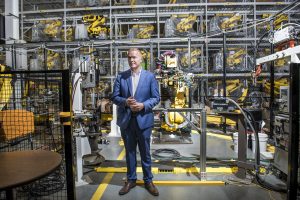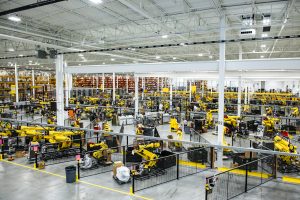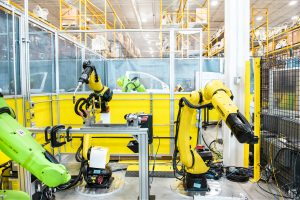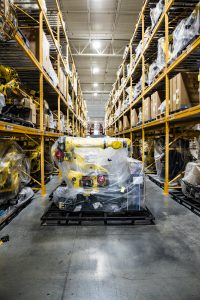
Just as Henry Ford revolutionized the auto industry with the introduction of the moving assembly line at Ford Motor Co.’s Highland Park plant in December 1913, the introduction of robotics over the last 40 years has transformed manufacturing in terms of productivity, quality, and safety.
And one of the first places the worldwide robotics industry made a significant footprint was within the automotive industry in metro Detroit.
Faced with the need to diversify its business and improve quality amidst the worst auto industry recession in the United States since the Great Depression, in 1982 General Motors and Japan’s FANUC Ltd. created GMFanuc Robotics Corp., a Troy-based joint venture designed to produce robots for automotive painting and welding operations.
FANUC, an acronym for Fuji Automatic Numerical Control, was established in 1972 at the foot of Mt. Fuji in Japan, where the company developed its first robot in 1974.
Although in the early 1990s GM divested all of its shares in the joint venture, the project helped revolutionize the auto industry and resulted in the establishment of FANUC America in Rochester Hills, headquarters for the Americas and a subsidiary of FANUC Corp., the market leader in automation in the U.S. and worldwide.
The company now has seven facilities in metro Detroit, 13 regional offices nationwide, two offices in Canada, three in Mexico, and three in South America. In addition, due largely to the auto industry, there are now more than 140 robotics and automation companies in Michigan.
Although 50 percent of FANUC America’s robotic sales are for the auto industry, the technology has expanded and transformed such industries as aerospace, agriculture, food and beverage, consumer goods, medical, pharmaceutical, transportation, and warehousing.
On the first floor of the company’s sprawling headquarters in Rochester Hills, a large display area provides customers and visitors with an opportunity to watch numerous robots and automated systems demonstrate just a few of their capabilities.
Those abilities include spot welding, painting, sorting pills, stacking heavy boxes, and lifting a car (a Chevrolet Corvette), to name a few.
Due to unprecedented demand, a year ago FANUC America, which has 2,000 employees, half of whom work in Oakland County, opened a massive, 650,000-square-foot West Campus facility on 67 acres in Auburn Hills at a cost of $110 million.
Since 2019, the company has invested more than $187 million in its local operations, including a 461,000-square-foot North Campus facility next to its headquarters, as well as new production centers in Canada and Mexico.
Looking down from the mezzanine of the new, brightly lit West Campus facility, one sees huge shelves containing an inventory of thousands of parts, and acres of yellow industrial robots and smaller, white collaborative robots (cobots) ready to be outfitted for the particular needs of FANUC’s customers.
While FANUC sells and works directly in designing robotics and automated systems with its largest customers, such as automotive companies, a growing percentage of sales are to system integrators — companies that determine the unique needs of the end users and work with those clients to install the technology.

All of FANUC’s robots and automated systems are manufactured in Japan, except for robots used for painting. Those are constructed at the Rochester Hills facility, where there are more than 200 robot and cobot model variants.
Two years ago, FANUC announced the production of its one-millionth industrial robot. Currently, the company is capable of producing 11,000-plus robots per month in fully automated factories that use its own robots to make robots.
During a recent tour of the West Campus facility, Lou Finazzo, vice president of FANUC’s automations systems group, pointed to an automation system that’s testing the storing and retrieving of battery trays used for the sequencing to a main assembling line.
At an “innovation lab” in another area, a cobot capable of changing its own end-of-arm tooling to pick up different parts performs quality inspections using built-in vision capability.
“When a customer buys a robot, nothing comes on the end of it, so we install the arm tooling and program it depending on the application,” says Finazzo, who has been with FANUC America for 31 years. “The auto company products have never changed so quickly (in recent years), and they need the flexibility of automation so they can dynamically change the product and not be stuck with legacy equipment.”
Finazzo says the robots alone generally cost between $20,000 and $200,000, depending on the size and application. Each unit can last up to 30 years.
“Anything we sell is serviced for life. We retain our customers and work really hard to make sure they’re successful,” he says.
In addition, the company offers a full range of robotics training including programming courses, electrical/mechanical maintenance, and advanced applications courses to its customers’ employees and those working in their integrator network at the FANUC Academy, currently located inside the Rochester Hills headquarters, and at satellite offices throughout the Americas.
In the near future, the main FANUC Academy will be expanded and relocated inside the former Cooley Law School building in Auburn Hills.
“Advanced automation requires new skills, and training is key to keeping manufacturing strong in North America,” says Mike Cicco, 48, who has served as president and CEO of FANUC America since 2016. “The FANUC Academy will become the largest corporate robotics and industrial automation training facility in the U.S.”
After the completion of the new FANUC Academy and other infrastructure projects, FANUC America will have invested more than $250 million in North America.

“FANUC’s products are best in class, with bulletproof reliability and the widest bandwidth of products at a very competitive price point,” says Greg Sandler, co-owner of Troy-based Dynamic Machine, an ASI-authorized FANUC systems integrator that works primarily in precision machining for component manufacturing. “They also provide great technical and customer support.
“What led us to an automation path is that some of our customers complained about the lack of labor, or labor unreliability. We buy the robots from FANUC for a modular automated drawer system called Cubebox, which houses parts that are then picked up and inspected by a robot that perhaps puts the parts in a lathe or whatever the customer wants it to do.”
Industry observers say the greatest challenges facing United States manufacturing are a labor shortage and the need to be more competitive with China, where factories are automating faster in manufacturing than anywhere else.
According to the U.S. Bureau of Labor Statistics, there’s a shortage of about 450,000 manufacturing workers in the country. A recent study by Deloitte and the Manufacturing Institute, meanwhile, showed the number could surge to 1.9 million openings, based on some 3.8 million manufacturing jobs likely to be needed between now and 2033.
In turn, there’s an ever-increasing demand for the use of robotics and automation throughout numerous industries worldwide.
The World Robotics 2024 report, published by the International Federation of Robotics (IFR), found that the countries with the most robots per 10,000 employees are (ranked in order): The Republic of Korea, Singapore, China, Germany, and Japan; the U.S. ranks 11th, with 295 units per 10,000 employees in 2023.
The study further found that the new global average robot density reached a record 162 units per 10,000 employees in 2023 — more than double the number measured only seven years earlier (74 units).
According to a recent Future Market Insights report, the industrial robotics market will surge to $291 billion by 2035 from 55.1 billion in 2025, in large part due to the rise of cobots built for precision in repetitive tasks and designed to safely work alongside humans in shared workspaces.
The report stated that cobot use will rise due to the increased use of artificial intelligence and machine learning that enables AI-driven decision-making and predictive maintenance, along with the rising demand for flexible, customizable robotic solutions.
Recognizing that robots had to be painstakingly trained by skilled engineers, in 2019 FANUC introduced an AI tool that teaches robots how to pick the right objects out of a bin with simple annotations and sensor technology. The new offering reduced the training process by hours.
“What AI doesn’t mean is that robots are going to take over the world,” Cicco says. “That’s never going to happen, because robots don’t think for themselves. They make an informed decision based upon information we’ve given them. Robots are able to make quicker and informed decisions because a human fed (them) with a bunch of information.”
Besides the need to meet increased demand for automation from industry sectors other than automotive, FANUC is expanding the technology into general assembly at automotive factories.
General assembly is considered the most manual and unpredictable state of vehicle production, and typically requires massive infrastructure upgrades and constant maintenance. Finazzo believes general assembly will see the largest grown in automation.
To that end, FANUC recently introduced the integration of its CRX cobot and other FANUC robot models with Inbolt’s real-time 3D vision and AI that gives robots the intelligence to perform production tasks alongside workers on the assembly line.
General Motors is the first auto manufacturer to use the integrated system.
“In general assembly, there are still important things for the workers to do, but collaborative robots will make their job more efficient,” Cicco says.
In May, at Huntington Place, FANUC demonstrated the new integrated system along with some of its other new robotic systems at Automate, the largest robotics and automation show in North America.

The event is annually hosted by the Association for Advancing Automation (A3) in Ann Arbor, which has 1,360 member companies involved with robotics, artificial intelligence, machine vision and imaging, motion control, and other automation technologies.
The four-day event clearly demonstrated the growing importance and future of robotics and automation, as the show set records with more than 875 exhibitors who demonstrated their technologies in front of 45,000 attendees.
In addition, more than 200 speakers and panelists held discussions on a number of topics including the future use of robotics and the challenges companies face as the Trump administration tries to bring more manufacturing back to America while competing with increasing automation in other countries.
Jeff Burnstein, president of A3, sees great opportunities and growth in the robotics and automation arenas, but he also recognizes the challenges.
“I see robotics and automation increasing over the long term, and we’re in the early innings in America,” Burnstein says. “Labor shortages are a factor, but the main reason is the need for companies to remain globally competitive.
“The advances in robotics, AI, and machine vision are advancing relatively quickly and if you’re not using them, competitors elsewhere are going to be. It’s not just in manufacturing. We’re seeing that virtually every industry is automating now or is considering it in life sciences, agriculture, construction, and fulfillment.”
According to Cicco, “The biggest challenge FANUC has now is that we have our own labor problem. That’s weird that I make robots and have a labor problem. We need more people who know how to program, install, and maintain them.” Burnstein agrees.
“The future of our world is going to be increasingly automated, and we’re going to need to have a skilled workforce that can operate the machine and develop new strategies,” he says. “We have to put a lot of emphasis on the next generation of the workforce.”
Mindful of the need for future workers, A3’s Automate trade show in Detroit hosted a record 1,200 students.
“We had an education pavilion, and students took part in robotics challenges,” Burnstein says. “They walked the show, and met with academic institutions that were there. It was a great learning experience for them.”
In an effort to try and inspire more young people to consider careers in robotics and automation, FANUC has placed robots in more than 1,600 high schools, community colleges, and universities since 2009.
The company also introduced robots and a curriculum to multiple prisons, military bases, and community centers in underserved communities.
In Michigan alone, FANUC has its robots in about 140 schools. The schools buy the robots at a greatly discounted academic price, while FANUC provides the curriculum, simulation software, and instructor certification for a robotics program that aligns with industry needs.
“One of the biggest challenges that keeps CEOs up at night is how are we going to find people to operate all of this technology?” says Paul Aiello, who has been director of education at FANUC America for the past 15 years. “The only way our customers can maximize their investment is to have trained employees.
“We want to reach students before they make pathways to a career decision, because they don’t know what they don’t know, and there are hundreds of career opportunities in robotics in different areas.”
Last year, FANUC America announced the establishment of a $1 million endowed scholarship fund in collaboration with the SME Education Foundation. It will provide annual scholarships totaling at least $50,000 to deserving students pursuing careers in advanced manufacturing.
“The fund aims to alleviate the financial burden of post-secondary education and create a robust pipeline of talent for the automation workforce,” Aiello says.
During a recent audit, the company determined its educational outreach initiatives have reached more than 1 million students since the program was launched in 2009.
“FANUC and our customers are trying to find a pipeline of talent, and we know we’ve made an impact because I’m sure a significant number of students have gone on to positions in robotics automation,” Aiello says.
According to The Future of Jobs Report 2025 from the World Economic Forum, broadening digital access is expected to be the most transformative trend — both across technology-related trends and overall — with 60 percent of employers expecting it to impact their business by 2030.
Advancements in technologies — particularly AI and information processing (86 percent); robotics and automation (58 percent); and energy generation, storage, and distribution (41 percent) — are also expected to be transformative.
It’s anticipated that these trends will have a divergent effect on jobs, driving both the fastest-growing and fastest-declining roles, and fueling demand for technology-related skills including AI and big data, machine learning, networks, and cybersecurity and technological literacy, which are predicted to be the top three fastest-growing skills, the report states.
“One of our strengths is our retention,” Finazzo says. “FANUC is a technical company, and what technical people want more than anything is challenge and creativeness. When you come to work here, nothing is a no.

“If you have an idea you might get some questions about it, but people embrace the desire to continue to improve and have better ideas. It’s very rewarding, and I think that’s why we retain most of our people. When someone retires, sometimes we think, ‘How are we going to replace someone with 40 years of experience?’ But right behind him or her is someone with 25 years.”
Cicco, who earned an electrical engineering degree at Bucknell University in central Pennsylvania and worked one year at Northrup Grumman as a lead automation engineer before joining FANUC in 1999 as a software supervisor in robot programming, says one part of his focus is on corporate culture.
“We operate as a big family while providing our employees a pathway throughout their career in various areas,” explains Cicco, who last year traveled to FANUC’s headquarters in Japan nine times. “We have a joint development organization between headquarters, and a very strong bond.” When asked what his secret to business success is, Cicco says it’s a sense of reinvention.
“Since I was a young child, I took things apart and put them back together and liked to figure out how things work,” he says. “The best show I’ve watched is ‘How It’s Made’ (a documentary TV series). I could sit and watch that show over and over again.
“I’ve been able to progress here because I went from actually doing the fixing to teaching others how to do it, then building a community of people. Now, as CEO, I’m the coach of the whole team. I don’t get my hands as dirty as I used to, and I miss that, but I derive joy now by seeing other people do it. Over the years, I’ve changed what drives me.”
Although FANUC America doesn’t publish its sales data and financials as a subsidiary of FANUC in Japan, Cicco foresees continuing expediential growth for the company.
“The pandemic created a huge demand for robotics and automation because of the labor shortage and early retirements,” says Cicco, who believes that automation played a key role in helping to battle COVID-19.
“We sold 2,000 robots that helped make masks, handle vials, and make test kits. Probably lives were saved because we were able to turn on automation so quickly.”
At the present time, Cicco says the tariffs announced by the Trump administration have caused some companies to delay moving forward with automation investments because the situation is chaotic.
“Our customers and future customers are frozen right now because they’re fearful and don’t know what it’s going to look like, (and neither) do we,” Cicco says. “Once it gets settled, then it will look a lot better because there’s a fundamental trade imbalance with the rest of the world, and there are more things that could be made here that aren’t.”
That being said, Cicco envisions having to once again expand FANUC America’s footprint because he and his team foresee there will continue to be a strong demand for robots.
“We had a number of leased facilities in the area, and the new West Campus facility was going to combine those, but because of demand we still need those other facilities,” he says.
“When the West Campus opened a year ago, I got a pit in my stomach seeing all this empty space and wondering how we were going to fill it. But now it’s full, so I anticipate having to create another new campus. Southeast Michigan will continue to be a key part of our growth.”
link

